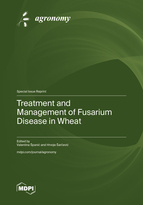Treatment and Management of Fusarium Disease in Wheat
A special issue of Agronomy (ISSN 2073-4395). This special issue belongs to the section "Pest and Disease Management".
Deadline for manuscript submissions: closed (17 February 2023) | Viewed by 22098
Special Issue Editors
Interests: wheat breeding and genetics; abiotic and biotic stress; plant defense
Special Issues, Collections and Topics in MDPI journals
2. Center of Excellence for Biodiversity and Molecular Plant Breeding, Zagreb, Croatia
Interests: wheat; maize; molecular markers; breeding for yield and quality
Special Issues, Collections and Topics in MDPI journals
Special Issue Information
Dear Colleagues,
Fusarium Head Blight (FHB), caused by several Fusarium species—mainly Fusarium graminearum, F. culmorum, and F. avenaceum,--is a devastating disease of wheat which reduces both grain yield and quality. FHB affects the grain protein content by destroying starch granules, storage proteins, and cell walls and consequently decreases the quality of dough properties. It is also associated with mycotoxin contamination and is a significant threat to animal and human health. Furthermore, Fusarium spp. affect plant development and trigger different morphological, physiological, biochemical, and molecular changes. Current climate change scenarios predict an increase in the number of epidemics caused by this disease, and many different strategies for disease control are currently being researched.
This Special Issue aims to bring the latest achievements on Fusarium disease in wheat, including the genetics or physiology of resistance, resistance mechanisms, host–pathogen interactions, and agronomic approaches in the field (fungicidal management, integration of host resistance and fungicides, timing of fungicide application). Original research, reviews, and opinions on recent advances in strategies for the control of Fusarium disease in wheat are also welcome.
Dr. Valentina Spanic
Prof. Dr. Hrvoje Šarčević
Guest Editors
Manuscript Submission Information
Manuscripts should be submitted online at www.mdpi.com by registering and logging in to this website. Once you are registered, click here to go to the submission form. Manuscripts can be submitted until the deadline. All submissions that pass pre-check are peer-reviewed. Accepted papers will be published continuously in the journal (as soon as accepted) and will be listed together on the special issue website. Research articles, review articles as well as short communications are invited. For planned papers, a title and short abstract (about 100 words) can be sent to the Editorial Office for announcement on this website.
Submitted manuscripts should not have been published previously, nor be under consideration for publication elsewhere (except conference proceedings papers). All manuscripts are thoroughly refereed through a single-blind peer-review process. A guide for authors and other relevant information for submission of manuscripts is available on the Instructions for Authors page. Agronomy is an international peer-reviewed open access monthly journal published by MDPI.
Please visit the Instructions for Authors page before submitting a manuscript. The Article Processing Charge (APC) for publication in this open access journal is 2600 CHF (Swiss Francs). Submitted papers should be well formatted and use good English. Authors may use MDPI's English editing service prior to publication or during author revisions.
Keywords
- Fusarium Head Blight
- resistance breeding
- host–pathogen interactions
- fungicidal approaches







